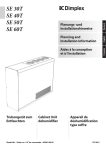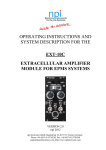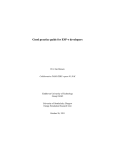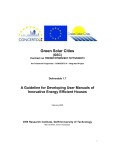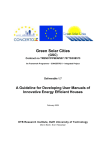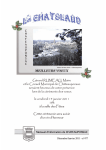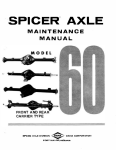Download NOMENCLATURE
Transcript
NOMENCLATURE 1. PERFORMANCES a CO2 MM CO2 dM/dtauCO2,in Vin va C PMV PPD , , dd ta W w Fw,in pw pw,s RH COP Air mass flow rate CO2 mass flow rate Molar mass Air CO2 concentration Variation of room indoor CO2 mass Room indoor volume Moist air specific volume Thermal imbalance of the human body Metabolism not converted in work and dissipated as heat Heat flow dissipated to ambiance through breathing and skin Metabolism Mechanical efficiency Enthalpy taken away by the breathing air Perspiration i.e. steam diffusion through skin Sweating steam diffusion Heat flow through clothing Radiation heat exchange with ambiance Convection heat exchange with ambiance Human body skin area Occupant susceptibility Predicted Mean Vote Predicted Percentage of Dissatisfied Factor equal to 1 when comfort is required, 0 when it isn’t Temperature set point during occupancy period Indoor temperature Time Degree-days Moist air dry temperature Moist air humidity ratio kgdryair Water mass flow rate Fictitious surcharge of indoor moisture capacity Water vapor partial pressure of moist air total pressure Water vapor partial pressure of saturated moist air Relative humidity of moist air System efficiency System coefficient of performance kg/s kg/s kg/kmol kg/s m3 m3/kgdryair W W W W W W W W W W m² % °C °C s K.day °C kgwater / kg/s Pa Pa - ‘Definition and Validation of a Simplified Multizone Dynamic Building Model Connected to Heating System and HVAC Unit’ G. Masy 2. SOLAR HEAT GAINS AND SKY RADIATION !, SF g "! "!# $ $% &, p + + , . / .# /# UTC ET 0 0 0 , " "# "!# "# 1 " ",# ",#, ",#, 2 2 2 ",# ",#, Heat gains from direct solar intensity through windows Window solar factor Glazing solar factor Ratio of frame area in the whole window area Direct solar intensity on a plane of a given slope and azimuth Window area including glazing and frame Direct solar intensity measured on a horizontal plane Angle between sum beams and normal direction to a given wall Angle between sum beams and vertical direction Window equivalent solar area including glazing and frame Wall slope (0 for horizontal position; '⁄2 for vertical) Sun azimuth (0 for sun on south, >0 for sun on west) Wall azimuth (0 for south facing wall, >0 for west facing wall) W W/m2 m2 W/m2 rad rad m2 rad rad rad Sun declination rad Latitude rad Longitude rad True solar time rad Longitude expressed in h h True solar time expressed in h h Coordinated Universal Time in h h Equation of Time in h h Clock time in winter h Clock time in summer h Solar time of the place under consideration h Heat gains from diffuse and reflected solar intensities through windows W Diffuse and reflected solar intensities on a plane of a given slope W/m2 Diffuse solar intensity measured on a horizontal plane W/m2 Direct solar intensity measured on a horizontal plane W/m2 Total solar intensity measured on a horizontal plane W/m2 Surrounding ground albedo Infrared radiation emitted by an area of a given slope W/m2 Infrared radiation emitted by an horizontal plane W/m2 Infrared radiation of a horizontal plane for clear sky conditions W/m2 Infrared radiation of a horizontal plane for covered sky conditions W/m2 Relative solar intensity at a given time Relative solar intensity for covered sky conditions 2 3 0,354 Relative solar intensity for clear sky conditions 2 3 1 Total solar intensity on a horizontal plane at a given time W/m2 Total solar intensity on a horizontal plane for clear sky conditions W/m2 ‘Definition and Validation of a Simplified Multizone Dynamic Building Model Connected to Heating System and HVAC Unit’ G. Masy 3. WALL MODEL DEFINITION ~ ~ t1 , t2 q~1 , q~2 / 9 : . 1 ; => < ?> @ A B C $ D Temperature variations expressed as complex quantities Heat flow variations expressed as complex quantities Pulsation Thickness Thermal diffusivity Thermal conductivity Mass density Specific heat Wall transmittance Wall admittance Frequency of a sinusoidal signal Dampening factor of a sinusoidal signal Wall heat transfer resistance Wall heat capacity Useful proportion of wall overall heat capacity Accessibility of wall overall heat capacity Wall overall heat transfer coefficient °C W/m2 rad/s m m²/s W/m.K kg/m3 J/kg.K W/m2.K W/m2.K s-1 m2.K/W J/m2.K W/m2.K 4. BUILDING SIMPLIFIED MODEL DEFINITION AE AFE , AFF BF AG BG BH A AH AI,%E , AI,%F BI E F G H #J DKH Heat transfer resistance of a zone light external walls Heat transfer resistances of a zone massive external walls Heat capacity of a zone massive external walls Heat transfer resistance of a zone massive internal walls Heat capacity of a zone massive internal walls Heat capacity associated to a zone indoor node Heat transfer resistance modeling zone ventilation heat losses Heat transfer resistance of light walls separating zones Heat transfer resistances of massive walls separating zones Heat capacity of massive walls separating zones Outdoor node temperature Node temperature associated to BF capacity Node temperature associated to BG capacity Indoor node temperature Ventilation heat exchange between zone and outdoor Transmission heat exchange between zone and outdoor Emission from zone heating system Heat gains from direct solar intensity through windows Heat gains from occupants, lighting and appliances Energy stored in BH capacity K/W K/W J/K K/W J/K J/K K/W K/W K/W J/K °C °C °C °C W W W W W J ‘Definition and Validation of a Simplified Multizone Dynamic Building Model Connected to Heating System and HVAC Unit’ G. Masy 5. BUILDING SIMPLIFIED MODEL VALIDATION L M Δ O P OQ R S T 0 U UV Outdoor heat flow response factor for indoor temperature impulse W/m2 Indoor heat flow response factor for indoor temperature impulse W/m2 Time step for the computation of walls response factors s Finite elements temperature interpolation matrix Finite elements temperature-gradient interpolation matrix m-1 Finite elements surface temperature interpolation matrix Finite elements capacity matrix J/K Finite elements conductivity matrix W/K Finite elements convection and radiation matrix W/K Heat transfer coefficient, including convection and radiation W/m2.K Finite elements nodal temperatures vector °C Finite elements surface nodes temperatures vector °C Indoor heat flow from convolution on zone response factors W,# Indoor heat flow response to outdoor temperature ,# Indoor heat flow response to indoor temperature for isothermal boundary conditions walls ,! Indoor heat flow response to indoor temperature for adiabatic boundary conditions walls .W,# Convolution correction factor for W,# .,# Convolution correction factor for ,# .,! Convolution correction factor for ,! W W #J #J,X B , Y Δ AZ 9[\ Y , Δ, &,W ,W : ] 0W ^, W W °C °C K-1 °C °C °C °C °C °C °C °C W/m2.K W/m² W/m² Emission from zone heating system Maximum emission from zone heating system Control factor Indoor temperature Temperature set point Control factor Invert of the differential of zone indoor temperature controller Reference indoor temperature Daily mean indoor temperature Daily indoor temperature amplitude Root mean square of the error on indoor temperature Indoor temperature dampening ratio Daily mean indoor temperature for a static computation Daily indoor temperature amplitude for a static computation Equivalent outdoor temperature Outdoor air temperature Shortwave absorption factor Emissivity Outdoor heat transfer coefficient (convection and radiation) Solar radiation reaching outdoor wall surface Sky radiation related to outdoor wall surface W W - ‘Definition and Validation of a Simplified Multizone Dynamic Building Model Connected to Heating System and HVAC Unit’ G. Masy 6. VENTILATION MODELS ∆\ ` Pressure drop through ventilation aperture Pa Air mass flow rate through ventilation aperture kg/s Air mass flow rate exponent (0 for laminar, 1 for turbulent flow) - < ∆\ \ a bW ∆\!W^^ c d b CSO CEO TO ∆\W ∆\W ∆\efg Constant of ventilation aperture resistance Wind pressure Wind pressure factor Wind speed Outdoor air specific volume Buoyancy pressure Acceleration of gravity Level Air specific volume Controlled Supply Orifice Controlled Exhaust Orifice Transfer Orifice Mechanical supply air mass flow rate Mechanical exhaust air mass flow rate Duct pressure drop Supply unit pressure drop including pressure balance device Pressure drop through Air Handling Unit Pa.(s/kg)1+n Pa m/s m³/kg Pa m/s² m m³/kg kg/s kg/s Pa Pa Pa 7. AIR QUALITY ANALYSIS CO2 CO2,set B h\[ h\[, Bij# ,W, Air CO2 concentration Air CO2 concentration set point Invert of the differential of indoor CO2 concentration controller Fan rotation speed Nominal fan rotation speed Chiller coefficient of performance Chiller condenser air supply temperature ppm ppm ppm-1 rev/min rev/min °C 8. SUMMER COMFORT ANALYSIS W PPD Outdoor temperature Indoor temperature Predicted Percentage of Dissatisfied °C °C % ‘Definition and Validation of a Simplified Multizone Dynamic Building Model Connected to Heating System and HVAC Unit’ G. Masy 9. CONNECTION WITH HEATING OR HVAC SYSTEM , Heating floor surface temperature Indoor temperature Water temperature ,W Temperature of the room under heating floor A, Heat transfer resistance between floor surface and indoor node A, Heat transfer resistance between water pipes and floor surface A Heat transfer resistance between water pipes and room under B Floor heat capacity X, Heat flow supplied by the heating floor to the zone W, Heat flow supplied by the water to the heating floor ,J Heat flow stored in the floor heat capacity ] Heating floor heat exchange efficiency B, Heating floor water heat capacity rate ,W, Heating floor water supply temperature ,X, Heating floor water exhaust temperature ,W,, Heating floor water supply set point temperature ,W,, Heating floor water supply temperature for nominal conditions °C °C °C °C K/W K/W K/W J/K W W W W/K °C °C °C °C W W, B B! B B °C °C °C K-1 K-1 Outdoor temperature Outdoor nominal temperature Indoor set point temperature Feed-forward proportional action factor Feed-back proportional action factor Invert of the differential of water supply temperature controller Invert of the differential of zone indoor temperature controller ,JW Ground capacity node temperature JW Ground temperature J,W, Brine-water heat pump evaporator brine supply temperature AJW,W Heat transfer resistance between ground capacity node and brine AJW Ground heat transfer resistance BJW Ground heat capacity Heat flow supplied to the brine-water heat pump evaporator W,JW Heat flow supplied by the ground heat exchanger JW,J Heat flow stored in the ground heat capacity °C °C °C K/W K/W J/K W W W NTU AU B B ] W/K W/K W/K - Heat exchanger number of transfer units Heat exchanger overall heat transfer coefficient Heat exchanger air heat capacity rate Heat exchanger water heat capacity rate Heat exchanger efficiency ‘Definition and Validation of a Simplified Multizone Dynamic Building Model Connected to Heating System and HVAC Unit’ G. Masy k a steam 0 0 0Jl ;J ; 0 0 k 0, ! A A A A D ] Moist air humidity ratio /kgdryair Air mass flow rate Steam mass flow rate Moist air enthalpy Steam enthalpy Latent heat of vaporization Vapor specific heat at constant pressure Air specific heat at constant pressure Convection heat transfer coefficient Mass transfer conductance Moist air humidity ratio for saturated air /kgdryair Enthalpy of saturated air at temperature Moist air wet bulb temperature Water side cooling coil thermal resistance Metal cooling coil thermal resistance Air side dry air cooling coil thermal resistance Air side saturated air cooling coil thermal resistance Wet cooling coil contact heat transfer coefficient Wet cooling coil contact effectiveness Wet cooling coil contact temperature kgwater kgdryair/s kgwater/s J/kgdryair J/kgwater J/kgwater J/kg.K J/kg.K W/m2.K kg/m2.s kgwater J/kgdryair °C m2.K/W m2.K/W m2.K/W m2.K/W W/K °C ‘Definition and Validation of a Simplified Multizone Dynamic Building Model Connected to Heating System and HVAC Unit’ G. Masy REFERENCES [1] IEA ECBCS Annex 3: “Energy Conservation in Residential Buildings” Anon; “Calculation Methods to Predict Energy savings in Residential Buildings” (1983) [2] IEA ECBCS Annex 10: J. Lebrun, G. Liebecq; “System Simulation Synthesis Report” (1988) [3] IEA ECBCS Annex 21: L. G. Mansson; “Calculation of Energy & Environmental Performance of Buildings: Technical Synthesis Report” (1998) [4] IEA ECBCS Annex 23: P. Warren; “Multizone Air Flow Modelling (COMIS): Technical Synthesis Report” (2000) [5] IEA ECBCS Annex 24: H. Hens; “Heat, Air and Moisture Transfer in Highly Insulated Building Envelopes: Technical Synthesis Report” (2002) [6] IEA ECBCS Annex 40: “Commissioning of HVAC systems” (2000-2005) Website : www.commissioning-hvac.org [7] IEA ECBCS Annex 43: “Validation of simulation models” (2003-2007) P. André, J. Lhoest; “Testing and Validation of Building Energy Simulation tools: Digest du rapport final de la sous-tâche C” (June 2007) [8] IEA ECBCS Annex 43: “Validation of simulation models” (2003-2007) C. Adam, P. André, B. Georges, J. Lebrun, V. Lemort, J. Lhoest, G. Masy; “Testing and Validation of Building Energy Simulation tools: Rapport de la première étude de cas (simulation intégrée) : maison résidentielle de Gesves” (June 2007) [9] G. Masy ; « Dynamic Simulation on Simplified Building Models and Interaction with Heating Systems », 7th International Conference on System Simulation in Buildings, Liège, December, 2006. [10] Ph. André, C. Aparecida Silva, J. Hannay, J. Lebrun, V. Lemort and V. Teodorese “Simulation of HVAC systems: development and validation of simulation models and examples of practical applications.” Keynote presented at Mercofrio 2006, Porto Alegre, Brazil, October17-20 2006 ‘Definition and Validation of a Simplified Multizone Dynamic Building Model Connected to Heating System and HVAC Unit’ G. Masy [11] Ph. André, J. Lebrun, V. Lemort, G. Masy, V. Teodorese “Développement de modèles pour la simulation des systèmes de chauffage, ventilation et conditionnement d’air.” Communication presented at the CFQ conference, Montréal May 2007 [12] Ph. André, B. Georges, V. Lemort, J. Lebrun, G. Masy “A friendly tool for comparative energy evaluation of different space heating systems in residential buildings.” Communication presented at the Passive House Symposium, Zolder 6 0ctober 2006 [13] X. Xu and S. Wang “Optimal simplified thermal models of building envelope based on frequency domain regression using genetic algorithm.” Department of Building Services Engineering, The Hong Kong Polytechnic University, Kowloon, Hong Kong, China. Energy and Building Conference, 2007 [14] G. Fraisse, C. Viardot, J. Hannay, G. Achard “Development of building Models based on Electrical Analogy.” Laboratoire Optimisation de la Conception et Ingénierie de l’Environnement Université de Savoie, France. Communication presented at the System Simulation in Buildings Conference, 2002 [15] C. Felsmann, G. Knobe, H. Werdin “Simulation of Domestic Heating Systems by integration of TRNSYS in a MATLAB/SIMULINK Model.” Communication presented at the System Simulation in Buildings Conference, 2002 [16] D. Herron, G. Walton, L. Lawrie; “Building Loads Analysis and System Thermodynamics (BLAST) program users manual” Army Construction Engineering Research Lab., Champaign, IL, 1981. [17] R. Sonderegger; “Dynamic Models of House Heating based on Equivalent Thermal Parameters” Princeton University Press, 1977. [18] M. Kummert “Contribution to the application of modern control techniques to solar buildings: simulation based approach and experimental validation” PHD Thesis, Fondation Universitaire Luxembourgeoise, 2001. [19] L. Laret « Contribution au développement de modèles mathématiques du comportement thermique transitoire de structures d’habitation. » Thèse de doctorat, Université de Liège, 1981. [20] F. Lorenz ; G. Masy « Méthode d’évaluation de l’économie d’énergie apportée par l’intermittence de chauffage dans les bâtiments. Traitement par différences finies d’un modèle à deux constantes de temps. » ‘Definition and Validation of a Simplified Multizone Dynamic Building Model Connected to Heating System and HVAC Unit’ G. Masy Université de Liège, janvier 1982 ; GM820130-01 [21] G. Masy « Building dynamic simplified model. » Working document IEA 43, February 2006. HEPL Rennequin Sualem ; GM060228-01 [22] G. Masy « Modelling of wall equivalent solar area. » Working document IEA 43, February 2006. HEPL Rennequin Sualem; GM060228-01 [23] P. Ngendakumana, J. Lebrun « Simulation thermique des bâtiments par des modèles simplifiés du second ordre : mode d’emploi et applications. » Université de Liège, décembre 1983 ; PNG831209-01 [24] P. Ngendakumana « Etude de l’introduction des phénomènes solaires dans les modèles simplifiés de bâtiments. » Université de Liège, octobre 1984 ; PNG841026-01 [25] P. Ngendakumana, G. Liebecq « Les facteurs de réponse simplifiés de paroi. » Université de Liège, février 1986 ; PNG860215-01 [26] P. Ngendakumana « Les facteurs de réponse simplifiés de paroi. » Université de Liège, février 1986 ; PNG860215-01 [27] « Comparison of Load Determination Methodologies for Building Energy Analysis Programs. » US Department of Energy, Washington Prepared for international Energy Agency Energy Conservation in Buildings & Community Systems Program, January 1981. [28] M. Sherman, D. Grimsrud « Measurement of Infiltration using Fan Pressurization and Weather Data. » Energy and Environment Division Lawrence Berkeley Laboratory University of California, 1980. [29] A. Blomsterberg, M. Modera, D. Grimsrud « Mobile infiltration test unit: Its design and capabilities, preliminary experimental results. » Energy and Environment Division Lawrence Berkeley Laboratory University of California, 1981. [30] M. Liddament « A Guide to Energy Efficient Ventilation.» ‘Definition and Validation of a Simplified Multizone Dynamic Building Model Connected to Heating System and HVAC Unit’ G. Masy Air Infiltration and Ventilation Centre University of Warwick Science Park, March 1996. [31] K. Bathe “Finite Element Procedures” Prentice Hall International Editions, 1996. [32] Recknagel, Sprenger, Hönmann “Manuel pratique du genie climatique” PYC Editions, 1986. [33] Ngendakumana P. "Modélisation simplifiée du comportement thermique d'un bâtiment et vérification expérimentale". Ph. D. Thesis in Applied Sciences. Université de Liège, Laboratoire de Physique du bâtiment, 1988 [34] S. Filfli “Optimisation bâtiment/système pour minimiser les consommations dues à la climatisation” Ecole des mines de Paris, 2006. [35] M. Dupont “Potentiel d’économies d’énergie par les services énergétiques – application au cycle de vie des équipements de conversion d’énergie ” Ecole des mines de Paris, 2006. [36] Davies, M. G. “Building Heat Transfer ” John Wiley & Sons, Chichester, England, 2004 [37] N. Heijmans, P. Wouters, Ch. Delmotte, D. Van Orshoven “La ventilation des immeubles de bureau: vers une meilleure expression des exigences ” Centre Scientifique et Technique du Bâtiment, 2005 [38] J.H. Klote “A General Routine For Analysis of Stack Effect »” U.S. Department of Commerce, National Institute of Standards and Technology, 1991 [39] CD-ROM Energie + UCL, Service Architecture et Climat [40] S. Bertagnolio, G. Masy, J. Lebrun and P. André “Building and HVAC system simulation with the help of an engineering equation solver” SimBuild 2008 Conference, Berkeley,USA. [41] J. Lebrun “Climatisation: le confort thermique” Notes de cours 2003-2004, Université de Liège. [42] Klein, S.A., Alvarado, F.L. 2002. ‘Definition and Validation of a Simplified Multizone Dynamic Building Model Connected to Heating System and HVAC Unit’ G. Masy EES : Engineering Equation Solver. F-chart software. [43] 11 Mars 2005- Arrêté du Gouvernement flamand établissant des exigences en matière de performance énergétique et de climat intérieur des bâtiments, Moniteur belge, vendredi 17 juin 2005. [44] « Prix d’achat de l’énergie par les ménages », APERE – Revue « Renouvelle », 1er trimestre 2007. [45] Logiciel « EPB software », Calcul du niveau E en Flandres Logiciel développé par DECYSIS. [46] Y.A. Cengel “Heat and mass transfer : a practical approach” Mc Graw Hill, 2006. [47] J. Lebrun “How to Effectively Use Advanced Research Energy Saving Technologies in HVAC Systems” Notes de cours donné à Gliwice, May 2004, Université de Liège. [48] D. Marchio, P. Stabat “Echangeur arrosé à plaques ou à tubes” Ecole des mines de Paris, Centre d’Energétique, août 2000. [49] G. Masy “ Modèle dynamique simplifié de bâtiment : définition et méthode de validation” Projet Sisal Minergibat, Rapport Semestriel avril 2007, Annexe 2. [50] G. Masy, V. Nicolaï “ Validation d’un modèle dynamique simplifié pour le secteur résidentiel ” Projet Sisal Minergibat, Rapport Semestriel avril 2007, Annexe 4. [51] G. Masy “ Building Tightness and Air Renewal ” IEA Annex 40, Final Subtask B2, Development of Functional Performance Testing procedures, January 2005. [52] O. Morisot, D. Marchio “ HEATEX échangeur de chaleur: modèle NUT-ε en enthalpie ou en température de l’HVAC2 Toolkit” Ecole des mines de Paris, Centre d’énergétique, mars 1999. ‘Definition and Validation of a Simplified Multizone Dynamic Building Model Connected to Heating System and HVAC Unit’ G. Masy












